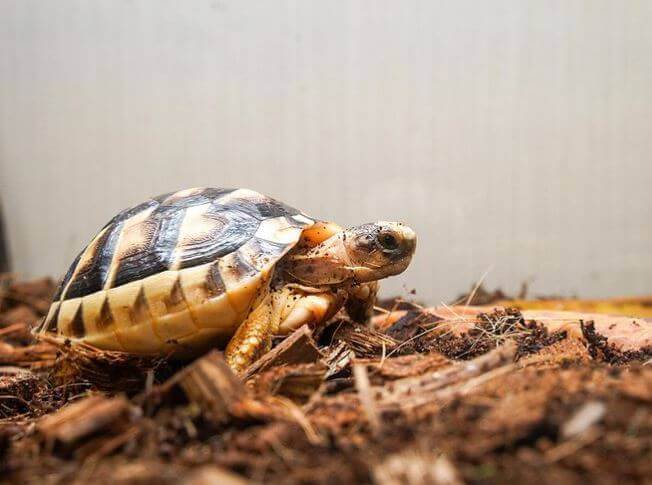When finding the best substrate for Leopard tortoise, it comes with a lot of available options on the market today.
But making the wrong decision could lead to significant health concerns for your pet along the way.
Therefore, before deciding, it is highly important to take into account all the substrate considerations.
You can choose the right product base on the age and size of the tortoise.
To avoid you from buying poor products, we will assist you with a few guidelines that you can follow for the wellbeing of your pet.
And as well as the instructions, we also give you an inventory of the right substrate products for your Leopard friend as well.
The Top-Rated Substrate For Leopard Tortoise (Recommendations)
#1. Exo Terra Plantation Soil – TOP PICK
#2. Zilla Pet Reptile Terrarium Substrate Bedding – EXOTIC CHOICE
#3. Zoo Med Forest Floor Bedding – PERFECT FOR HUMIDITY CONTROL
#4. Fluker’s 36005 Repta-Bark All Natural Bedding – NO DUST MATTER
#5. Reptile Sciences Terrarium Sand – DIGESTABLE OPTION
#6. Zoo Med Eco Earth Loose Coconut Fiber Substrate
Related:
- Best Bioactive Substrate For Leopard Gecko
- Best Substrate For Bearded Dragons
- What Kind Of Substrate For Bearded Dragons?
- Best Turtle Substrate For Your Pet Tank
What Do You Need To Know About The Best Substrate For Leopard Tortoise?
Leopard tortoises have their specific requirements about their captivity living environment, as are many other reptiles.
They favor horizontal tanks with good heating and lighting systems, moisture levels between 75 and 80%, and a temperature range between 25 and 35 degrees Celsius.
Some plants (both real and artificial) are also needed for an ideal environment, offering shade, hiding, sleeping, and cooling shelter.
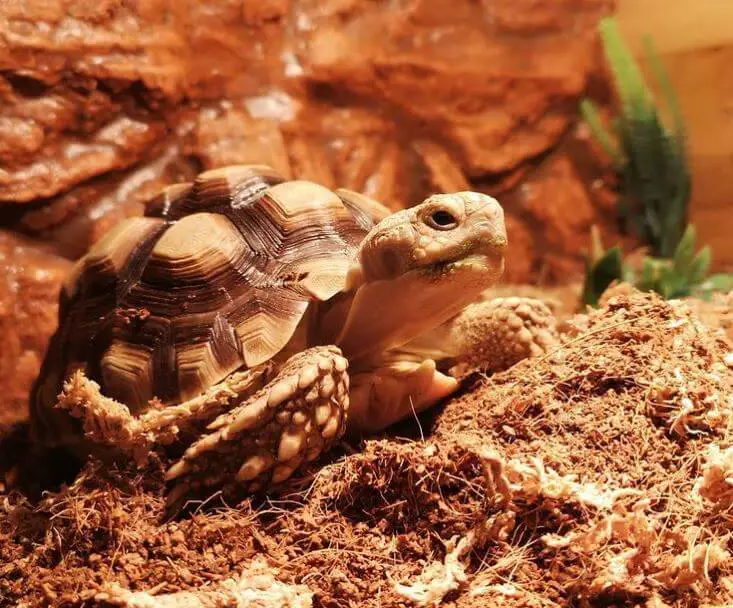
1. What Are The Features Of A Good Substrate?
-
Easy to dig:
Leopard tortoises like digging and burrowing.
A good substrate should be easy for the pets to dig in so that they can live happily and enjoy their living far from home.
It also must be structural integrity enough to maintain its shape after being dug, rather than collapse.
-
Not cause impaction:
Regardless of how much you try to control, the animals may chew the substrate at any time.
This represents a risk to the wellbeing of your pet and is one of the hazards for pet owners as an unsuitable substrate can cause bad impaction.
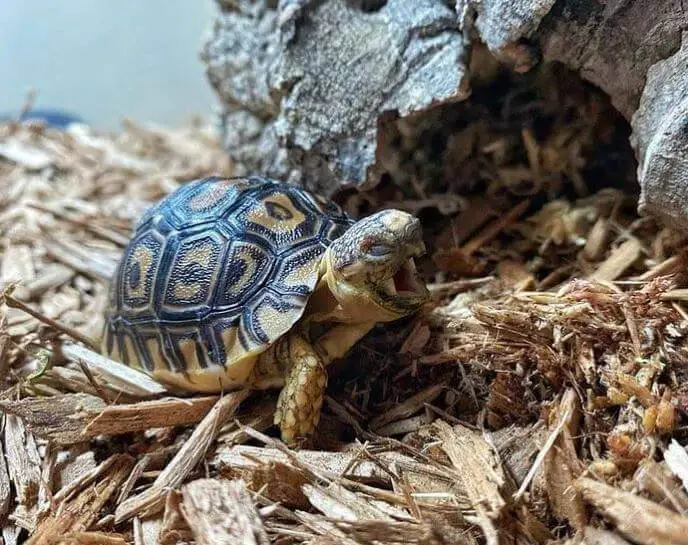
-
Stable shape:
Your pet will spend almost all of their time walking on it, so keep in mind to choose a bedding that is stable and easy to walk.
If you choose large chunks of coarse materials, it is usually unstable and not easy to walk, especially for hatchlings.
There are smaller particles that are easily accessible and tightly packed, yet if it is too fine, it makes it difficult for the tortoises to sink through.
-
Nonpoisonous:
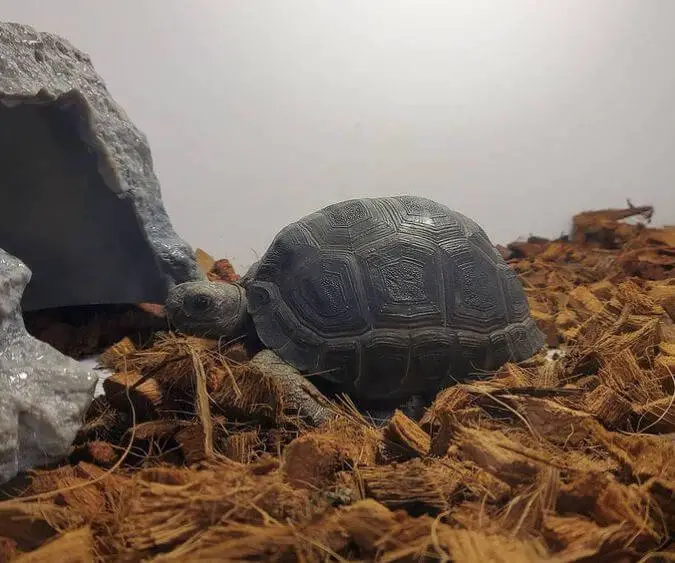
This is an important matter because toxic bedding might kill your pets.
Contrary to what you think, certain substrates that may seem good to you is toxic to your Leopards.
Hardwood or mulch, for instance, is usable as substrates, but in fact, it is a safe choice.
Some produce toxic resins that could harm the tortoises, thus you have to make sure that all the materials you choose are healthy.
A substrate is a layer placed as bedding and flooring in the bottom of the tank.
Your Leopard tortoise must be able to walk on or laid on it.
When you need to clean or change depends on the form of the substrate used.
However, it is also good to find products that are easy to clean up or replace, in order to keep the tank clean as long as possible and maintain the habitat inside.
Moreover, the substrate must not irritate the skin of the tortoises and should not enable the accumulation of dust to harm their respiratory system.
2. What Kinds Of Materials That You Should Not Use
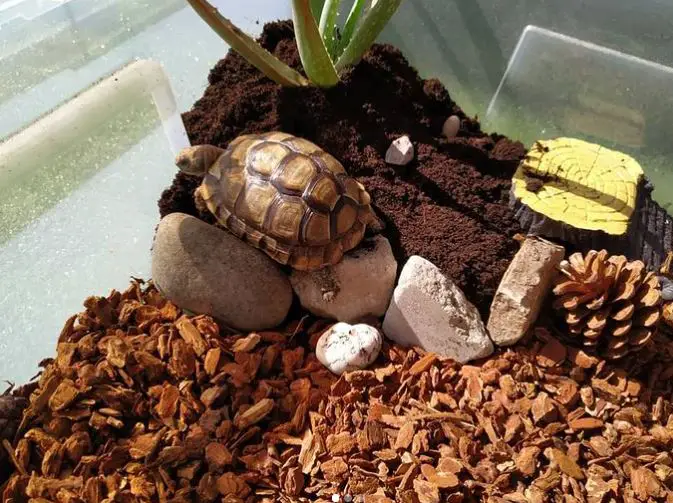
Wood:
Tortoises can be splinted by it.
The problem is that they may eat it by mistake, triggering inside their intestines.
And it is also easy to be exposed to high temperatures, it can catch on to a fire.
Dusty:
The dust from the substrate will contribute badly to the breathing difficulties of the animal.
Fiber:
This is a popular substrate, but if they are not properly held, they can become hazardous.
Their downside is that it is capable to readily grow molded and might give your pet a whole bunch of health problems.
If the fiber substrate is not kept wet, it gets very gritty, leading to respiratory issues.
But if used carefully with caution, fibers may be a decent substrate.
Do not forget to replace it periodically.
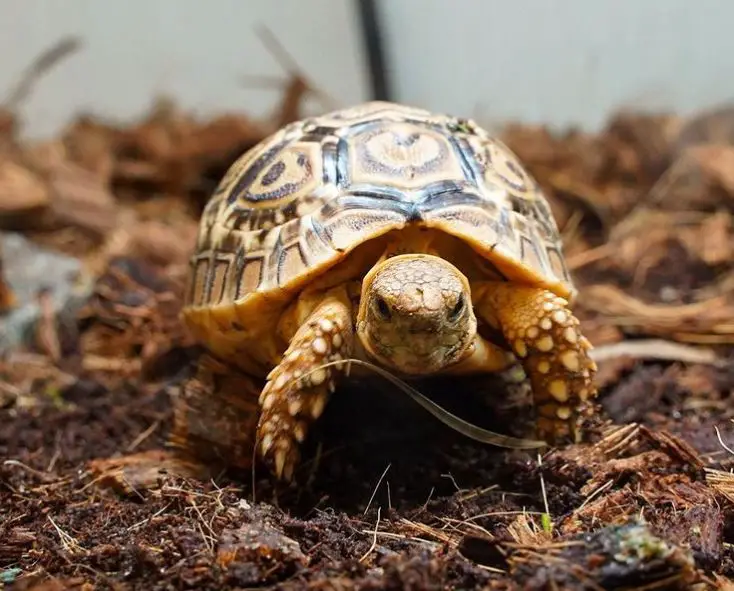
Paper:
Every kind of paper is bad.
It does not offer any benefit to your animal, moreover, it gets moldy easily and can catch fire in just a moment.
Alfalfa:
This is highly absorbent, making it perfect to sustain the housing clean.
But they will dehydrate the tortoises as well.
There is a lot of protein available, however, this could be terrible if they start to eat too much of it.
Best Substrate For Leopard Tortoise Shortlist (Updated List)
*Ratings are from Amazon at the time of publication and can change
The Best Substrate For Leopard Tortoise
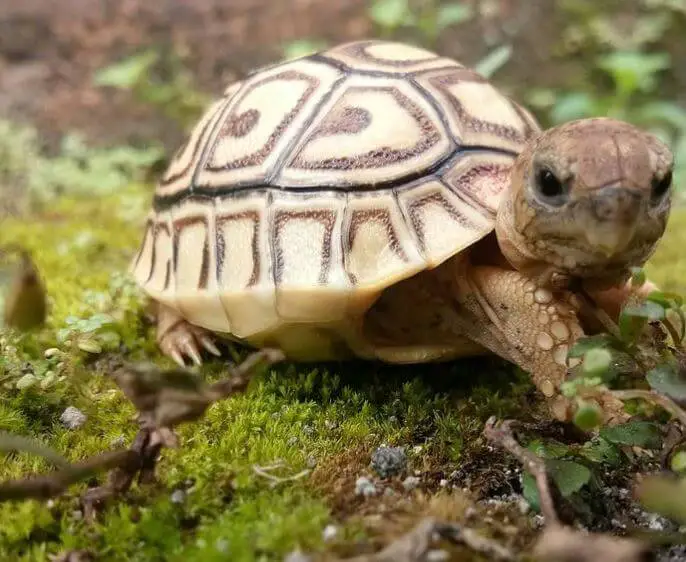
#1. EXO TERRA PLANTATION SOIL – TOP PICK
- Type: Coconut husk
The Exo Terra Plantation Soil is our top pick as the best Leopard tortoise substrate.
It is made from the compressed coconut husk, which helps the animal to dig into, hide or relax.
This product is perfect for moisture keeping, and if you want to grow living plants inside the terrarium, this is also a nutritional substrate as well.
We would suggest just use some coconut fiber for the hot months of the year, but this means you will have to be more vigilant.
Like we said earlier, they could be moldy, as long as you hold it for too long, so you have to change it after one or two months.
Just be careful that you do not let them dry down. If they get too dry, they might be stunned, which is going to make your pet in trouble.
And please keep it away from the basking area.
Pros:
- 100% natural
- Good for humidity retaining
- Encourages the digging and burrowing behaviors
- Nutritional for living plants
Cons:
- Dries up fast
- Might contain soil mites
- Can be moldy easily
#2. ZILLA GROUND ENGLISH WALNUT SHELLS DESERT BLEND – EXOTIC CHOICE
- Type: Ground walnut shells
Zilla Ground English Walnut Shells Desert Blend is an ideal choice for animals who live in a dry natural desert climate.
Its 100% natural shells give them soft and warm bedding to live on.
These products are the best seller because it packs well and does not irritate the pet’s skin.
A lot of buyers say that their tortoises really like burrowing it.
Moreover, the ground walnut shell is lightweight and smoother than sand, making your tortoise more comfortable.
Thus, you do not have to think about scratching inside the glass cage.
One more advantage for you to consider is it can be composted as yard waste, giving environmental benefit and easy to clean up.
Pros:
- Recommended for desert reptiles
- Does not leave scratch inside the tank
- Offers strong heat conduction
- Encourages digging and burrowing behaviors
Cons:
- Not safe if the pet accidentally eat the substrate
- Has tiny bugs in among the shells
- Can be hazardous for juvenile
#3. ZOO MED FOREST FLOOR BEDDING – PERFECT FOR HUMIDITY CONTROL
- Type: Cypress mulch
Zoo Med Forest Floor Bedding is made from cypress mulch, which makes it a fantastic best substrate for Leopard tortoise choice for your pet.
It is perfect for humidity control, therefore, you do not have to worry about this.
Just remember to handle the level of moisture since Leopard is a low moisture reptile, and if It gets too dry, it will hurt your pet’s feet.
This product will not create mold, even with the high humidity content.
Thus, it is another amazing quality of the bedding that makes it great for your tortoise.
With this substrate, you can easily spot-up leftover food or waste.
Pros:
- Good for retaining moisture
- Easy to clean up
- Waste spotted easily
- Does not create the mold
Cons:
- Reported to have mites
#4. FLUKER LABS REPTA BARK ALL NATURAL BEDDING – NO DUST MATTER
- Type: Orchid bark
Fluker Labs is one of the most famous brands when it comes to pet products.
Thus, when it comes to the question of what is the best substrate for Leopard tortoise, you do not have to think twice about the quality of their Repta Bark All Natural Bedding product.
To improve the relaxation and replicate a natural environment, you should give this a try.
Although it is best for high humidity required reptiles, it also works well with the Leopard ones.
All you have to do is control the content level of humidity.
This bedding helps keep the cage clean since it quickly absorbs moisture and dust.
Pros:
- All-natural material
- Absorbs water and prevents excessive moisture
- Bigger pieces reduce the chance of ingestion
- Less dust
Cons:
- Loaded with mites
- Molds in high humidity
- Dirty if it is too damp
- May kill cleaner bugs
#5. REPTILE SCIENCES TERRARIUM SAND FOR AQUARIUM – DIGESTABLE OPTION
- Type: Calcium carbonate
Reptile Sciences Terrarium Sand is what came to our mind when talking about a desert substrate for desert animals.
You do not have to worry about the health risk when your pet accidentally consumes it like the other normal sand products.
This product is totally calcium carbonate and yes, digestible.
In addition, it has some extra elements such as potassium, strontium, as well as magnesium.
This product makes your pet feel at home, he can comfortably do his natural behaviors such as digging or burrowing.
Pros:
- Digestible
- Neutralizes odor
- Encourages digging
Cons:
- Still can cause some impaction
#6. ZOO MED ECO EARTH LOOSE BAG
- Type: Coconut husk
Zoo Med Eco Earth Loose Bag is made of recyclable fibers, keep your tortoises safe and happy.
For terrariums struggling to recreate natural habitats, it is a good choice and is also applicable to many other species.
You will obtain all the advantages as a coconut fiber substrate, such as natural, nonpoisonous, antibacterial, mold-resistant, and moisture-retaining.
If you have a pet that enjoys burrowing, no need to worry!
All you need to do is to cover the base of your terrarium with this product with an appropriate depth at least twice the height of your pet, and you are all set.
Pros:
- Good price
- Mold and bacterial resistant
- Easy to clean up thanks to the clumps and droppings
Cons:
- Can get dirty when in contact with water
Setting Up The Best Substrate For Leopard Tortoise
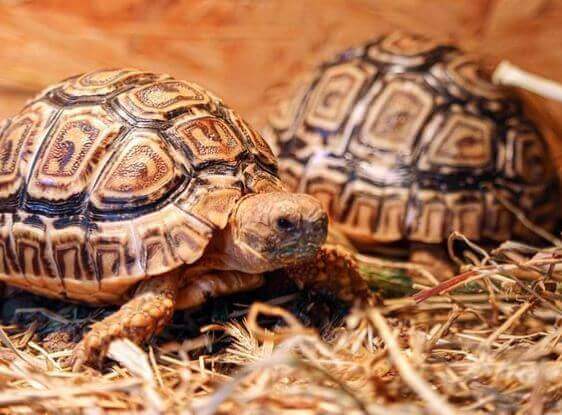
Source: reptilesmagazine
There are two significant factors that affect the living condition the most:
-
Humidity:
Every different tortoise species lives in different places, therefore they adapt to different climates.
In fact, certain ones are accustomed to several levels of moisture.
You can not just put one animal living in desert areas in a high humidity condition, it will lead to health issues.
One of the most significant tasks of humidity is helping the animals to retain a stable temperature inside their shell.
In fact, a wet substrate would be slightly hotter than a dry one.
And since tortoises rely on their surroundings to change their body temperature, it becomes very necessary.
The pet will most certainly end up shell rot if the dampness is too high in no time.
And their skin and shell will also be affected the most if they do not get the hydration they need.
-
Surroundings and bedding:
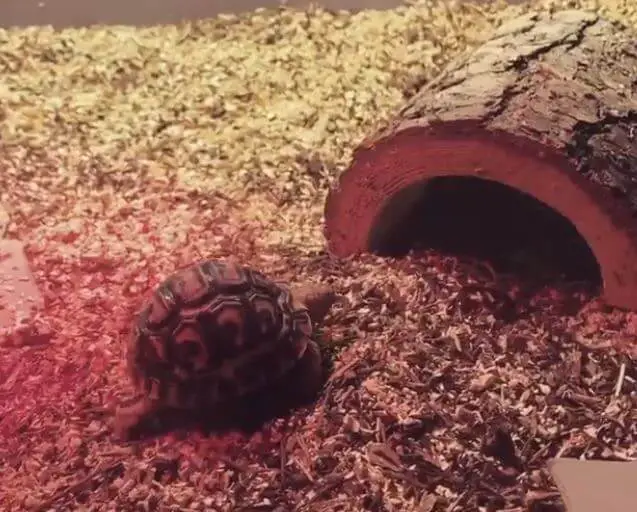
Like many other tortoises, the Leopard ones love to dig and they do this for various purposes.
Sometimes it is about getting off the heat, and sometimes it is just fun.
Thus, it is crucial to choose a material that encourages digging, and you would also need to make them as deep as it can be.
The proper depth of the base is about 6 inches, but since it needs a lot of space, not every owner can afford it.
However, it is suggested that you should have at least 2 inches deep in the bedding.
Perhaps it is more challenging for the pet owners to recognize whether to change their substrates, sometimes they just leave it for a long time.
It does not have one proper time for altering the layer since this relies on variables such as depth, tank capacity, and others.
For a 2-inch substrate, you can change it roughly 3 or 4 months later.
You would need to change the substrate after 5 or 6 months if you had bedding 6 inches deep, and you do not actually have to change the entire tank.
All you can do is cut out the first three inches and replace it.
You have to look in closely at your pet’s natural habitat and try to imitate it as best as possible if you want to create the perfect microclimate for him.
Especially to Leopard tortoises, you need to remember that they are Africa reptiles, a very hot and dry place.
Check out this video to see how to set up and clean tortoise enclosure: Cleaning My Tortoise Enclosure & Setup – YouTube
Getting the best substrate for Leopard tortoise ensures you a healthy and happy animal.
What are the signs of a healthy tortoise? You can check on the following photo.
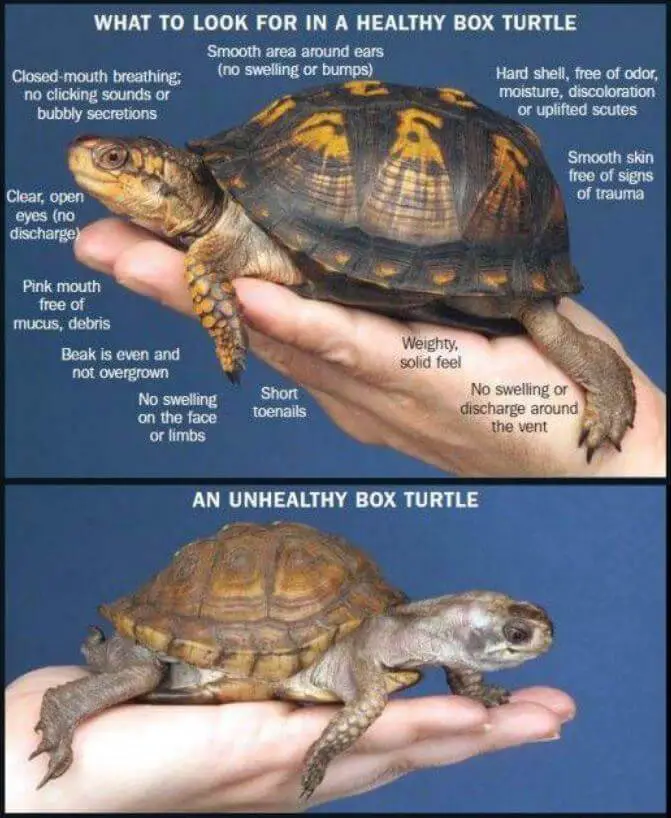
What are the signs of a healthy tortoise?
Frequently Asked Questions About Choosing The Best Substrate For Leopard Tortoise
1. Are The Leopard Tortoises Friendly?
They are usually well known as not the most entertaining pets.
Although most of them might confuse one finger for food, the Leopards biting people are not frequently reported. In the wild, during the mating season, men can get violent against other men.
However, in captivity, they are relatively docile.
2. Should I Leave My Leopard Shell Pet Live Alone?
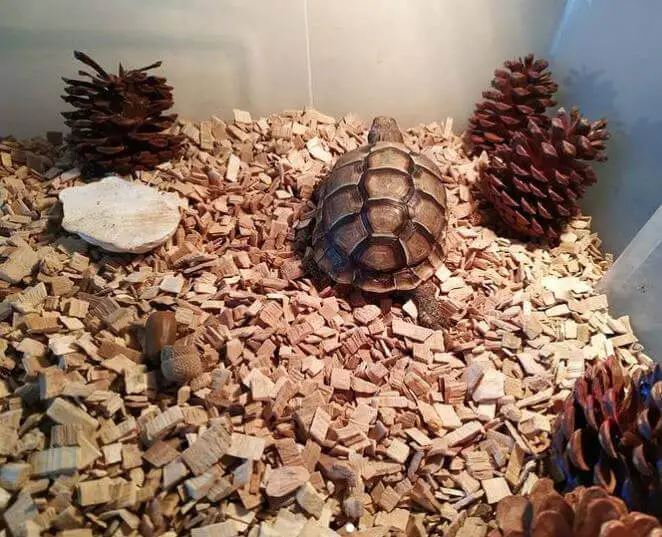
Like many other reptiles, tortoises have not evolved for an incorporated desire for communication.
They are comfortable all by themselves in the wild.
In fact, they are not that far from their wild habitat even when being in captivity, therefore, they are fine being alone.
3. How To Clean My Substrate?
Every day, you should soak your pet and let him poop it out there. So he will not create waste in his cage. By this, you can stir the substrate up every few weeks.
Remember to remove the leftover food and water bowls every day.
We recommend you replace the whole substrate every couple of months.
4. What Can I Feed My Leopard Pet?
Leopard tortoises need food that often consists of grass and leafy weeds, such as timothy hay and orchard grass.
You can give them clover, plantain, dandelion, spineless cactus pads, prickly pears, and succulents, too.
5. Do The Leopard Species Require Humidity?
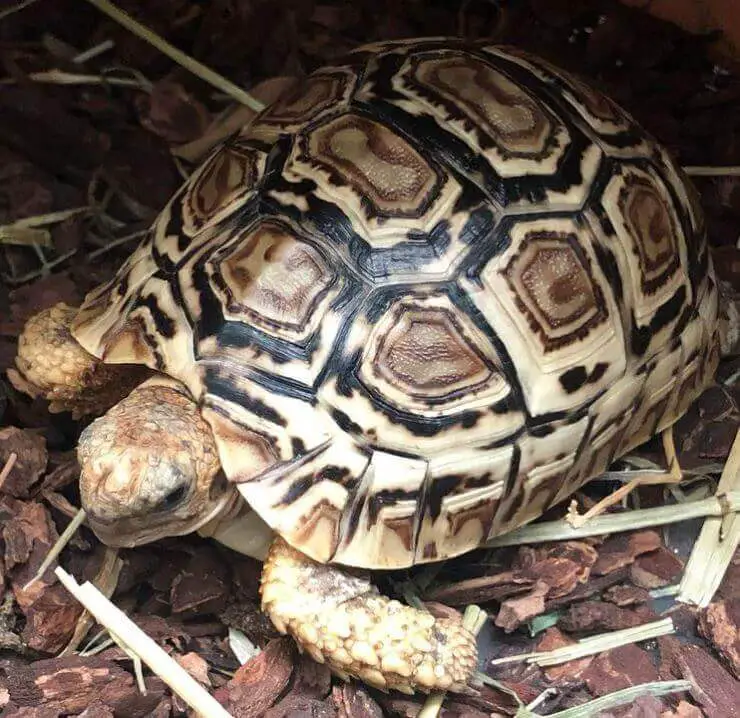
Source: exoticpetvet
During the first year after being born, the hatchlings require 75 to 80 percent of humidity. Some people say that because their natural habitat is dry and arid, therefore, they really need to be hydrated when they are still small.
Conclusion
Tortoises in general, and Leopard ones in particular, are kind of easy to keep.
Nonetheless, recognizing the risks posed by the bad equipment and living conditions needs to be understood carefully.
Impaction is one of the main dangers that damage your pet.
However, it is possible to prevent the chance of harm by choosing a proper substrate, retaining a pleasant and stable living habitat.
These will take the life of your pet long and happy.
If you are still considering, we suggest choosing EXO TERRA PLANTATION SOIL since it is also our top pick.
It can satisfy all the basic needs of your Leopard pet, as well as environmentally friendly.
REPTILE SCIENCES TERRARIUM SAND FOR AQUARIUM is also a good choice.
It does not only provide a good natural look to your terrarium, but the material itself also made from 100% digestible calcium carbonate.
You will not have to worry if your pet puts it in his mouth.
Choosing the best substrate for Leopard tortoise does not have to be difficult. With a little research and preparation, you will be able to pick the right product. Taking time to read all the details that we tackled in this article as well as on the internet carefully will also help you.
Key points for leopard tortoise substrate:
1. Suitable Substrates for Leopard Tortoises:
- Naturalistic Environment: Leopard tortoises benefit from substrates that mimic their natural habitat, providing comfort and promoting natural behaviors.
- Options for Substrate: Several substrate choices are suitable for leopard tortoises:
2. Recommended Substrates:
- Topsoil and Sand Mix: A blend of topsoil and sand in a 60:40 or 70:30 ratio offers a suitable substrate. Ensure it’s free from chemicals, fertilizers, or pesticides.
- Coconut Coir: A mixture of coconut coir and sand can serve as a viable substrate, providing good moisture retention and a burrowable texture.
- Orchid Bark: Orchid bark mixed with sand or topsoil can offer a loose, well-draining substrate for tortoises.
3. Substrate Considerations:
- Avoid Pine or Cedar: Stay away from substrates like pine or cedar shavings, as they can emit aromatic oils harmful to reptiles.
- Particle Size: Ensure the substrate particles are small enough to be ingested accidentally, leading to potential impaction issues.
4. Substrate Depth and Maintenance:
- Depth Requirement: Provide a substrate depth of 4-6 inches to accommodate burrowing behaviors and maintain proper humidity levels.
- Spot Cleaning: Regularly remove feces and soiled substrate to maintain cleanliness and prevent odor buildup.
5. Humidity Control:
- Moisture Retention: Substrates like coconut coir aid in moisture retention, helping to maintain appropriate humidity levels within the enclosure.
- Misting and Spraying: Periodically mist or spray the substrate to increase humidity, especially in arid climates or during dry seasons.
6. Importance of Heating:
- Heat Retention: The substrate assists in heat retention, particularly at night, helping to maintain appropriate temperatures for the tortoise.
- Heat Distribution: Use of under-tank heating pads or heat emitters beneath the substrate can aid in distributing heat evenly throughout the enclosure.
7. Monitoring and Adjustments:
- Regular Checks: Monitor substrate conditions regularly, ensuring it remains clean, dry, and free of mold or fungal growth.
- Behavioral Observations: Watch for signs of discomfort or dissatisfaction, as tortoises may exhibit specific behaviors indicating they’re unhappy with the substrate.
Choosing the right substrate is essential for the health and well-being of leopard tortoises. The substrate should offer a balance of comfort, moisture retention, and ease of maintenance while allowing the tortoise to express its natural behaviors in a safe enclosure environment. Regular monitoring and adjustments are vital to ensure a healthy substrate environment for your pet tortoise.
Further Reading:
- Top 7 Best Substrate For Chameleons – Complete Guide
- Best Substrate For Sulcata Tortoise: Guideline For The New Keepers
- Best Substrate For Russian Tortoise
- 20+ Tips to Setup Beardie Tank

